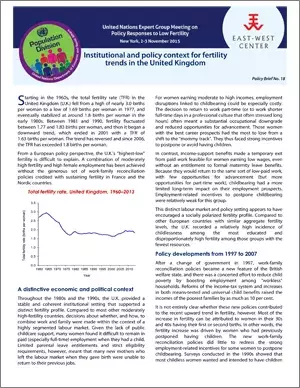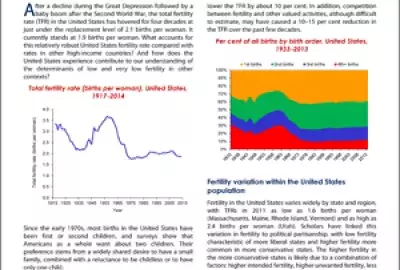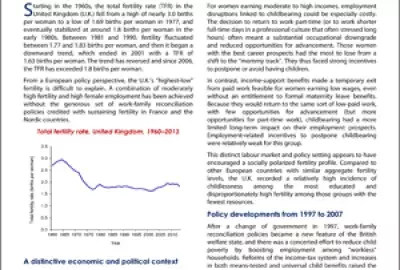Error message

Starting in the 1960s, the total fertility rate (TFR) in the United Kingdom (U.K.) fell from a high of nearly 3.0 births per woman to a low of 1.69 births per woman in 1977, and eventually stabilized at around 1.8 births per woman in the early 1980s. Between 1981 and 1990, fertility fluctuated between 1.77 and 1.83 births per woman, and then it began a downward trend, which ended in 2001 with a TFR of 1.63 births per woman. The trend has reversed and since 2006, the TFR has exceeded 1.8 births per woman. From a European policy perspective, the U.K.'s "highest-low" fertility is difficult to explain. A combination of moderately high fertility and high female employment has been achieved without the generous set of work-family reconciliation policies credited with sustaining fertility in France and the Nordic countries.
|
Starting in the 1960s, the total fertility rate (TFR) in the United Kingdom (U.K.) fell from a high of nearly 3.0 births per woman to a low of 1.69 births per woman in 1977, and eventually stabilized at around 1.8 births per woman in the early 1980s. Between 1981 and 1990, fertility fluctuated between 1.77 and 1.83 births per woman, and then it began a downward trend, which ended in 2001 with a TFR of 1.63 births per woman. The trend has reversed and since 2006, the TFR has exceeded 1.8 births per woman. From a European policy perspective, the U.K.'s "highest-low" fertility is difficult to explain. A combination of moderately high fertility and high female employment has been achieved without the generous set of work-family reconciliation policies credited with sustaining fertility in France and the Nordic countries.
|
Policy Briefs - United Nations Expert Group Meeting on Policy Responses to Low Fertility







